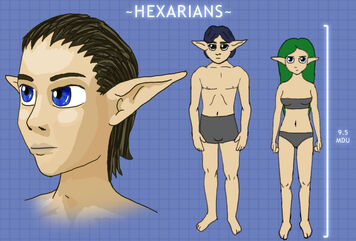
Statistics
Common Attribution: Hexarian
Categorical Attribution: Saruki hexra
Evolutionary Star System: Dejenna System
Star Systems of Prominence:
Population Data: 9 billion
Largest Civilisation: Hexarian Star Republic
Civilization class: Type B: Interstellar Society
Overview
Hexarians are bipedal humanoids characterised by large eyes and cranium, in addition to their signature elongated ears that protrude sideways from the head and taper to a point. Their bodies are compact and generally lightweight, although they tend to have fast metabolisms and a natural lifespan of just 20 GY (it should be noted that this is heavily augmented by their medical technology to beyond 40 or 50). As such they are supple and swift moving, but are not capable of living long if starved of essential nutrients or water.
Unusually for sentient carbon-based species, Hexarians are an atheistic race; having never developed the concept of religion. They are also notable for a minor capacity for extrasensory abilities; although tiny in comparison to the Estari. Low genetic variance in their behaviour and limited geneological similarity with other native species has led to many controversial theories regarding their origin.
Evolutionary History
Hexarians were thought to have evolved from the primate group Saruki on Hexar and share a common ancestor with the Kvorn, another sentient species from Hexar. Recent evidence has drawn theories that they might have at least partially originated from the Aiju, a hypothetical race that spread genetic material across star systems many millions of years ago. This is not widely accepted, however.
Hexarians have evolved a powerful sense of vision to the relatively dim sunlight of Dejenna. Their ears are well developed, although a slight regression from their Saruki ancestors (who had very acute hearing as they were nocturnal hunters). Their fast metabolism and high sustenance requirement is believed to stem from the particularly bountiful natural resources of Alutai, their continent of origin.
Biology
The Hexarian race has a frightfully voracious metabolism, resulting in noticably sharp movements and thought at a rate of 1.3 times the standard for their mammalian index. They are bipedal, with two upper limbs ending in five-digited hands. They have a large head and large eyes, with long ears pointing out to the sides and at a slight angle backward. Their blood is based on Hemocyanin, and is dark blue and fairly viscous. This is thought to be another reason for the very strong muscles in the heart, and contributes to the almost always paleness of the skin. The upper back of their head is the only part of their body on which hair grows, typically in black or brown shades although green and blue are common as well.
Hexarian gestation is over 1 GY and their reproductive rate is lower than average. While conception is the same as most sexual bipedal species, birth occurs through a narrow slit in the abdomen that is otherwise normally sealed. This is thought to be an evolutionary result of increasingly large head size. The slit, or Lira-Kush, loosens during contractions, eventually seperating. In the days following the birth, it re-seals, usually leaving what's known as the Mother's Mark. This method of birth is more likely to draw infection, further worsening Hexarian reproductive robustness. Hexarian infants are born highly developed, however.
Psychology
Socially, Hexarians are an altruistic and compassionate race. They have little history of internal conflict, mostly having eradicated it by the beginning of the Elvan Republic era (although this is likely down to increasing confliction with the Kvorn). Since becoming a notable power within their sector, they have fallen into the role of mediators, diplomats and peacekeepers.
Extrasense organs found in the Hexarian brain indicate an innate ability to interact with psionic forces, although not to the degree of some other races.